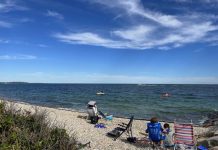Frothy white waves butting up against rugged seaside cliffs, soft sandy beaches, lush forests and valleys, and then more ocean. . . You may want to spend all waking hours in Nova Scotia out of doors. And it’s highly probable you will.
Adventures
If you’re a sailor, a surfer, or any sort of seafarer, you’ll find no dearth of adventures in Nova Scotia. Take a boat out whale watching, or kayak out through misty coves to mysterious islands around Tangier or in search of shipwrecks.
Get the adrenaline rush of riding a tidal bore, the massive waves created when more than 100 billion tons of water flows into the Bay of Fundy at high tide. Perched on your Zodiac, you’ll hear its primeval rumble before you see its crest, the liquid rollercoaster that will lift you skyward and then drop you, drenched and giddy, back down again. Tide comes in twice a day. After a day of river rafting, stay the night at the super affordable Tidal Bore Motel (starting at $49 per night), and get the best view of the bores, taking satisfaction in the waves you just conquered.
If “two if by sea” becomes too much, take to the land with hikes along the cliff footpaths, or a bike ride up and down the hilly and breathtaking Cabot Trail on Cape Breton.
Wonders of Nature
Nature abounds and surrounds in Nova Scotia, but even here there are a couple of highlights. Southwest Nova Biosphere Reserve is the largest protected wilderness area in Atlantic Canada, spanning five counties. Its coastal area is populated by quiet fishing villages and some of the oldest French settlements of the New World. Inland you’ll find Kejimkujik National Park, the only inland national park of Canada in the Maritimes, with nine major rivers and more than 120 lakes canoe routes, and phenomenal hiking trails. The entire area was designated by UNESCO for its commitment to sustainable development and conservation—it is home to a good many endangered species, including the southern flying squirrel.
Yet another ideal place to connect with nature is Brier Island in the Bay of Fundy. The small basalt island is the westernmost point of the province, situated where the Gulf of Maine and the Bay of Fundy meet. Life is slow and friendly on this rugged island, where fishing boats come and go, and whales swim, and seals sun themselves on the rocks at Seal Cove. Geology buffs will enjoy the rock formations, and a wealth of quartz, jasper, amethyst. The island is accessible by two short ferry rides from the end of Digby Neck, and well worth a few days of nature-communing and relaxing. You can find comfortable beds—and ocean views—at Brier Island Lodge (rooms start at $89). A word of warning: one look at this nature-lover’s paradise and you may never want to return.
Relaxation
It starts with a rocky bluff jutting out into the ocean and adorned by a postcard-perfect lighthouse. And then there are surf-worthy waves and lounge-worthy sands, waters the warmest they get north of the Carolinas. The territory is almost completely surrounded by water, and that’s not counting the placid lakes you’ll encounter in its interior. So if it’s seaside bliss you’re looking for, let your search stop here.
Head out to the sleepy southern coast, with its granite boulders and busy fishermen, where you truly feel like you just might be at the edge of the world. Once prime territory for pirates, the area is dotted with small towns and a long, rich history—and it’s easy to navigate without a car. Take scenic strolls along white sand beaches and through wooded forests, visiting the historic towns along the way, mingling with the friendly, laid-back locals, and dining on the catch of the day.
Then get in a round or two of golf at one of more than 60 courses in the region, or cast your line in one of its 6,500-plus lakes or rivers. And don’t forget to save at least a day for lounging on one (or several) of the regions incredible beaches.
For a true treat, venture out to Cape d’Or. The “Cape of Gold” is not the easiest place to get to, but a peaceful retreat most certainly worth the trek. At the lighthouse is the view of all views: sharp cliffs, green forests on the gentle promontory, and the most adorable inn and restaurant, which was once the lighthouse keeper’s house. The Lighthouse on Cape d’Or is truly an experience, with basic rooms (starting at $80 per night) and unparalleled views. This is what they mean when they say “get away from it all.”
How to get there: Fly into Halifax International Airport. There are shuttles from the airport to many hotels. Since the province is so large and taxis can be a bit pricey ($50 from the airport into Halifax, this is one place where it might make sense to rent a “green” car for navigating between the regions. The bright side is that once you reach whatever destination you have in mind, you won’t be needing much of the car, since there are so many places to walk and bike and hike.










 Sarah Knapp is a Brooklyn based entrepreneur whose love for the outdoors and community building led her to the October 2013 creation of OutdoorFest. She has a BA in History, is a Wilderness First Responder and a NY state hiking, camp and boating guide. Her proudest achievement to date is reading the Aeneid in Latin.
Sarah Knapp is a Brooklyn based entrepreneur whose love for the outdoors and community building led her to the October 2013 creation of OutdoorFest. She has a BA in History, is a Wilderness First Responder and a NY state hiking, camp and boating guide. Her proudest achievement to date is reading the Aeneid in Latin.  Allison was one of our first top writers and Chief Editor but is no longer working with offMetro. Allison is a native New Yorker, who has lived in Rome, Tuscany, Melbourne, Toronto and Los Angeles. She frequently contributed travel pieces to Family Travel Forum, using her own children as guinea pigs as they travel the globe. She never missed a chance to sample local delicacies, as her love for travel goes hand-in-hand with her love for food and wine.
Allison was one of our first top writers and Chief Editor but is no longer working with offMetro. Allison is a native New Yorker, who has lived in Rome, Tuscany, Melbourne, Toronto and Los Angeles. She frequently contributed travel pieces to Family Travel Forum, using her own children as guinea pigs as they travel the globe. She never missed a chance to sample local delicacies, as her love for travel goes hand-in-hand with her love for food and wine.  Josh Laskin is a freelance travel writer and photographer based in the White Mountains of New Hampshire. When he is not at work or on the road, you can find him in the mountains snowboarding, climbing, hiking, fly fishing, mountain biking, and eating bagel bites.
Josh Laskin is a freelance travel writer and photographer based in the White Mountains of New Hampshire. When he is not at work or on the road, you can find him in the mountains snowboarding, climbing, hiking, fly fishing, mountain biking, and eating bagel bites. Annie is a travel writer, environmentalist, and surfer based in Venice, CA. She heads up our West Coast team, keeps our grammatical errors in check, and makes sure our California writers always have a plan for their next adventure. Follow Annie’s travels @annelisemcb.
Annie is a travel writer, environmentalist, and surfer based in Venice, CA. She heads up our West Coast team, keeps our grammatical errors in check, and makes sure our California writers always have a plan for their next adventure. Follow Annie’s travels @annelisemcb. Carly Pifer is a freelance writer who has been known to follow whims inspired by romantic movie scenes or colorful street style shots to India, Japan, Tunisia and Argentina. After stints living in Seoul, Boston, Paris and Los Angeles, writing and searching for something intangible, she landed somewhat steadily in Brooklyn and has begun to find inspiration in her more immediate surroundings.
Carly Pifer is a freelance writer who has been known to follow whims inspired by romantic movie scenes or colorful street style shots to India, Japan, Tunisia and Argentina. After stints living in Seoul, Boston, Paris and Los Angeles, writing and searching for something intangible, she landed somewhat steadily in Brooklyn and has begun to find inspiration in her more immediate surroundings.  Kate E. O’Hara is a New York based freelance writer and photographer who loves all things food—especially the people who make it and market it. Her writing aims to capture the essence of the food experience; the stories that go well beyond a plate of ingredients. In addition to her love of food, Kate is also known to have a hankering for red wine and craft beer. You can also find Kate on Instagram
Kate E. O’Hara is a New York based freelance writer and photographer who loves all things food—especially the people who make it and market it. Her writing aims to capture the essence of the food experience; the stories that go well beyond a plate of ingredients. In addition to her love of food, Kate is also known to have a hankering for red wine and craft beer. You can also find Kate on Instagram